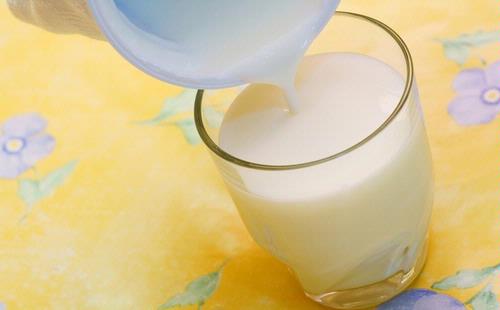Since hundreds of years ago kefir has been known as a health drink, rich in nutrients, and able to ward off various diseases. These dairy products can cause a great feeling.
Kefir is a drink derived from milk, fermented by a number of microbes, namely lactic acid-producing bacteria (BAL), acetic acid-producing bacteria and yeasts (yeast).
Kefir beverage has been known since several centuries ago in the former Soviet Union, particularly in the northern Caucasus Mountains. The word comes from Turkish kefir, keif which means good feeling or feeling good. So called because someone will feel good after consuming kefir regularly.
At first kefir is made inadvertently, that puts the milk has been added kefir seeds in bags made from sheepskin. The bag was hung on the door, so that everyone passing through the door will automatically touch the bag, so sway. It turned out to give the effect of stirring to milk, thus helping to smooth the process of fermentation by microbes.
For decades, the secret of making kefir is only known by generations by the natives of the Caucasus Mountains. New in 1908, for the first time kefir seeds successfully brought out of the Caucasus Mountains to the city of Moscow. From the city's property and kefir-making technology spread throughout the world.
Currently kefir is very well known in Europe and traded with various names, kephir, kiaphur, kefyr, knapon, kepi and kippe. Popularity kefir is supported by scientific evidence that it contains probiotics (live bacteria) and components, which are crucial for health. That is one of the secrets of longevity of the population of the Caucasus.
Increased Folic Acid
The main ingredients are the seeds of making kefir and milk kefir. Bibit kefir can be obtained by purchasing or from the process of making kefir before. If stored correctly, kefir seeds can be used repeatedly without limit. Milk used to milk cows, goats, sheep or buffalo, either in powder form (full or skim milk) or liquid (full-cream, low-fat or non-fat). Given the technology is very simple, making kefir can be done in the household scale.
Initially pasteurized milk, which is heated at a temperature of 85 degrees Celsius for 30 minutes or at a temperature of 95 degrees Celsius for 5 minutes. The goal is to kill unwanted microbes and mendenaturasi proteins, thus facilitating the work of microbes in the fermentation process. After the milk is cooled in the pot or jar until it reaches room temperature (20-25 degrees Celsius), to which was added kefir grain seed as much as 5-6 percent (50-60 g of seeds for 1 liter of milk kefir).
Mixture of milk and kefir seeds subsequently brooded at room temperature for 24 hours, until complete clotting occurs. Kefir can be improved aroma and flavor by curing the way back to the refrigerator temperature 80-10 degrees Celsius for 15-24 hours. Subsequently filtered to separate the liquid kefir kefir from kefir grains (can be used to create a new kefir). The longer the curing is done, diminishing levels of lactose (milk sugar), but the more acidic taste. Longer curing will also increase levels of vitamin B and folic acid. Durable power of kefir liquid can be extended up to one week of storage at cold temperatures (around 10 degrees Celsius).
The technique of making kefir is more a work of art rather than scientific activities. Long fermentation and fermentation temperature are the two things that really determines the texture and flavor that will produce kefir. In hot climates, milk fermented with kefir seeds quite done for 18 hours. After that, kefir seeds must be separated from the liquid kefir.
Fermentation is too long will produce kefir is very thick and sour. Kefir is good only slightly thicker than fresh milk, so it is easy to drink.
Seeds Kefir
Seeds often called kefir kefir grains, kefir granules, natural-starter or natural-mother-culture. Bibit is a biomatriks a soft, white, contains proteins, fats, and complex polysaccharides (kefiran). Kefiran levels can reach 45 percent of seed dry kefir. Bibit kefir contains a number of lactic acid bacteria (BAL) and yeast (yeast), each play a role in the formation of flavor and structure of the kefir.
Kefir seeds yellow-white color and shape of granules (granular) resembles a cauliflower. At first small in size (size of a grain) and if often used to grow until a shelled walnut. Wet kefir grains as much as 50 grams can grow to twice that in 7-10 days, if transferred into 500 ml fresh milk six times a week.
Bibit kefir comprises a mixture of various bacteria and yeasts. Species of microorganisms in kefir seeds consists of four major genera, namely Lactobacilli, streptococci / Lactococci, Acetobacter, and Yeast (yeast).
Each microbe has a special role, such as lactic acid forming, mucus (matrix kefir grains), diasetil, ethanol, and carbon dioxide. Bibit kefir can not be dried by heating because most microorganisms in it will die. Bibit kefir is still active, if preserved by freeze drying (freeze drying). The best way to store seeds of kefir is moving into the old seed that has been pasteurized milk regularly, brooded overnight and stored in a refrigerator temperature of 4-7 degrees Celsius. Under these conditions kefir seeds remain active for about a month. @
Prof. DR. Made Astawan Lecturer Department of Food Technology and Nutrition IPB

No comments:
Post a Comment